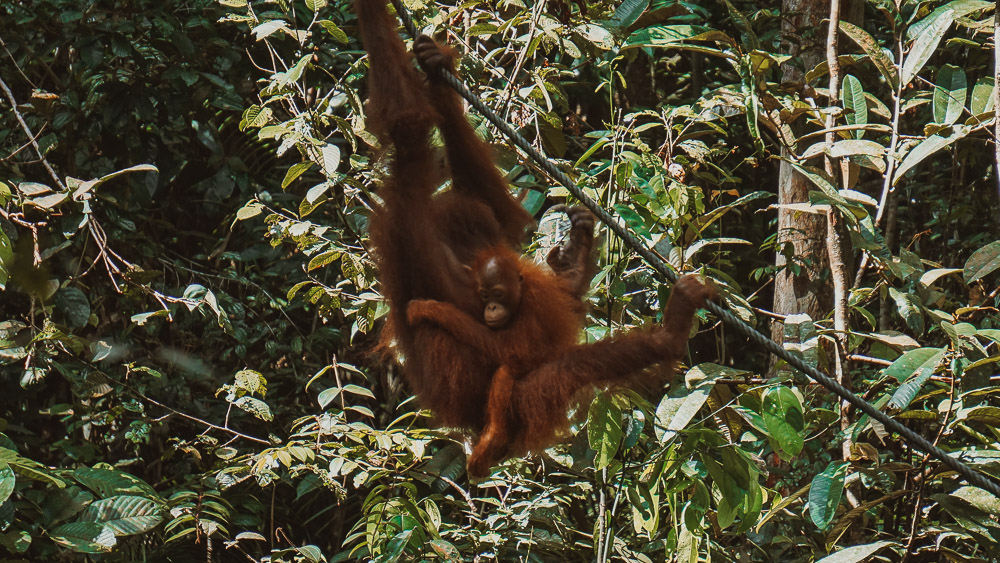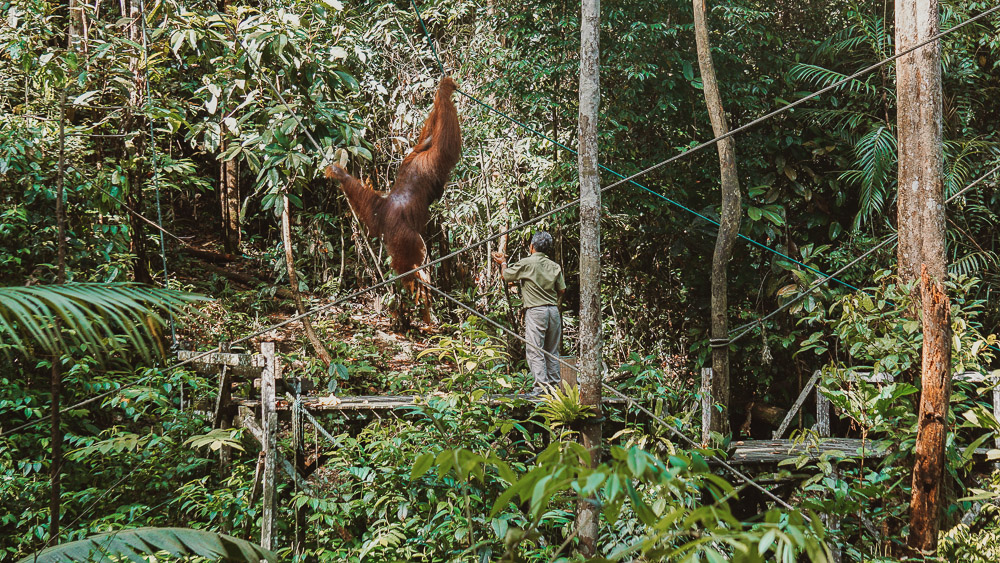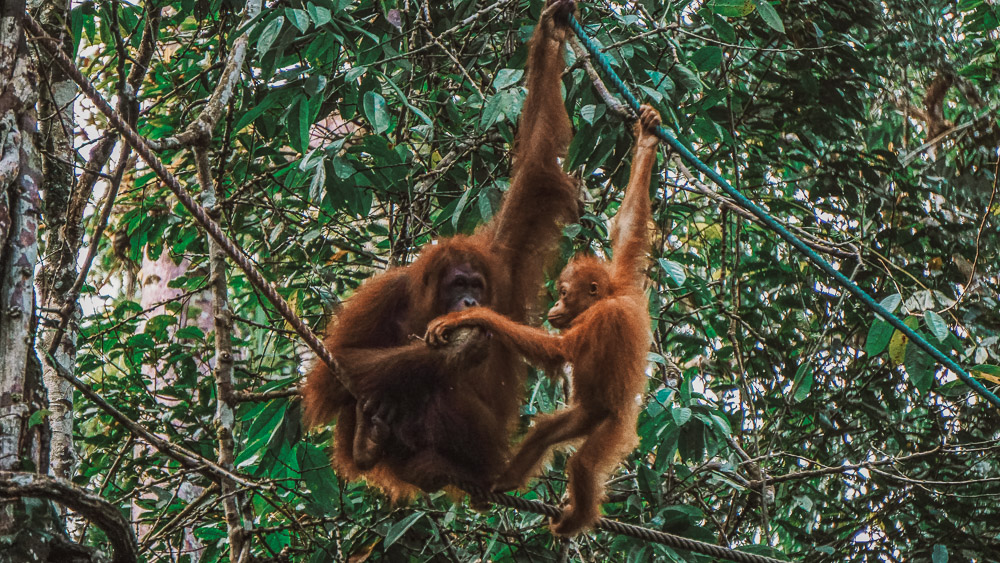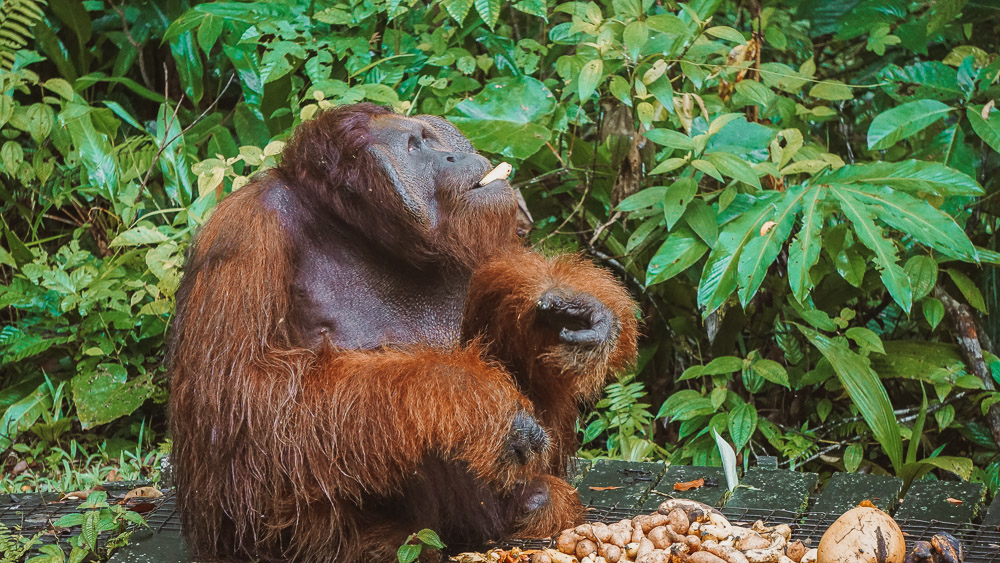The word ‘orangutan’ means man of the forest in the Malay language. It is not hard to see why, with these primates sharing 96.4% of our human genes. Today, on international orangutan day I have been reminiscing on the incredible experiences I have been fortunate to have, coming face to face with the man of the forest in Borneo.
For most people visiting the exotic, and often unknown Borneo, seeing an orangutan is at the top of their bucket list. I spent four months living and studying in Kuching, the capital of the Malaysian state of Sarawak in Borneo. Throughout this time, I was lucky enough to have a couple of different encounters with these beautiful animals, and I am so excited to share one particularly memorable encounter with you in this post.
A short drive from the city centre of Kuching is the Semenggoh Nature Reserve. This sanctuary is home to semi-wild orangutans who have previously been injured, orphaned or illegally kept as pets. The purpose of the centre is to rehabilitate orangutans and release them back into the wild if appropriate. The orangutans are free to roam the forested area, of over 600 hectares.
The opportunity to see the man of the jungle is a total chance, and they are not behind any bars or in cages. Each day, the caretakers enter the forest at feeding time, climbing up a series of platforms in the canopy. They have a variety of fruits for the orangutans, and they will call out for them to come and eat. It is up to the orangutans if they would like to swing in and grab a free meal. During the fruiting season, when the trees in the forest are laden with fruit, the orangutans aren’t likely to come and eat from the platforms, as they can easily find their own lunch!

Caretaker on the feeding platforms at Semenggoh Nature Reserve (image by Sally Sees)
The first time I visited Semenggoh, I recall getting off the local bus on the main road, at the entrance to the reserve. The sun blazing, and the air was sticky. The hum of the insects in the forest was deafening. I had a long walk down the driveway, to reach the entrance to the reserve. By the time I got close, there was a flurry of activity. People were rushing out of the information centre and heading down the path towards the jungle. A few people turned around and beckoned to me, to hurry down with them. I wasn’t sure what we were looking at, but if someone says ‘come, quick!’ you tend to follow. By the time I pushed my way to the front of the small crowd forming, I locked eyes with Ritchie.

Ritchie at Semenggoh Nature Reserve (image by Sally Sees)
Ritchie is the big boss around the reserve. Born in 1981, he was nothing like what I imagined when I fantasised about seeing these primates. His flanges (cheek pads) were huge, and I was so close I could see the patterns and lines adorning them. I felt him looking directly at me, and I was so shocked and overwhelmed I didn’t know how to feel. I never expected to come literally face to face with such a large creature.
Because the orangutans are semi-wild and free to roam the reserve, there is nothing stopping them from coming out of the forest, especially if they’re hungry! Ritchie was looking for an early feed that he didn’t have to share with his mates, so he had wandered out into the area near the entrance, and attracted quite the crowd.

Ritchie at Semenggoh Nature Reserve (image by Sally Sees)
After a long time of being completely fixated on this huge primate, Ritchie wandered off back into the forest. I followed the series of paths leading into the forest to the feeding platform where the caretakers were calling for the other orangutans and throwing around a range of tropical fruits. It had been almost half an hour and no other orangutans had appeared. I was a little disappointed, but how could I complain after the close encounter I had just experienced? That is the beauty of seeing animals in their natural habitat. It is completely up to them if they feel like interacting with humans, and the orangutans will only swing in if they want to.
Just when the crowd around me started to get restless, with people beginning to leave, there was a rustle in the trees. The rustling grew louder, and eventually, I saw flashes of orange in the distance, swinging between branches. It took a while for the orange fur to eventuate, and once it did I realised there wasn’t just one orangutan, but a mother with her baby. I think at this point there were tears forming in my eyes.

Mother and baby at Semenggoh Nature Reserve (image by Sally Sees)
I couldn’t believe how privileged I was to be graced with the presence of these wild creatures. I sat transfixed as the mother guided her baby around the trees, and made their way to the caretaker to grab some fruit right from his hand. Once mum and her baby had all the fruit they wanted and swung off into the jungle, and I was sure there were no other orangutans hanging around waiting for a turn, I headed back to the information centre.

Orangutan taking fruit from caretaker at Semenggoh Nature Reserve (image by Sally Sees)
Seeing an animal as special and intelligent as an orangutan is a truly humbling experience. In one way, it didn’t feel right to see them this close. To be locking eyes with a wild animal. But sadly, meeting the orangutans in this setting is safer than what their life would be like in the wild. Here the orangutans are safe from palm oil plantations, raging fires and illegal wildlife trade. It’s like they can sense that these interactions with humans, although maybe not how nature intended their lives to go, are a better alternative for them.

Mother and baby at Semenggoh Nature Reserve (image by Sally Sees)
Orangutans are a critically endangered species and these great apes face a number of threats. Loss of their natural habitat is among the greatest threats to the existence of orangutans, with forests in Borneo and Sumatra being bulldozed for both legal and illegal palm oil plantations, and other agricultural purposes. Each year raging fires burn across the jungle to clear plantations and prepare the land for new crops, adding another threat to orangutans.
There is illegal logging occurring inside protected areas, and over 50% of orangutans in the wild are found outside of protected areas, in forests under management by timber, palm oil and mining companies (WWF). When orangutans enter these agricultural zones, they are at risk of being killed by hunters, either for food or as a retaliation for the damage they have caused to crops, when they can’t find any other food source. Illegal wildlife trade is another threat to these primates, with young orangutans still being kept as pets in countries like Indonesia.
There are a number of things we can do to help the plight of the orangutans, and protect these great apes:

Ritchie at Semenggoh Nature Reserve (image by Sally Sees)
The Sustainable Traveller works with a number of ethical tour companies who offer tours to Borneo that visit orangutans. Browse these tours on our website here, or get in touch to work with one of our journey advisors to plan your Borneo orangutan adventure.
